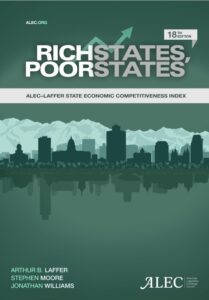
New Mexico
Economic Outlook Rank
New Mexico is currently ranked 33rd in the United States for its economic outlook. This is a forward-looking forecast based on the state’s standing (equal-weighted average) in 15 important state policy variables. Data reflect state and local rates and revenues and any effect of federal deductibility.
Current Economic Outlook (2025)
| Policy | Value | Rank |
|---|---|---|
| 5.90% | 30th | |
| 5.90% | 21st | |
| (change in tax liability per $1,000 of income) | $15.77 | 41st |
| (per $1,000 of personal income) | $21.81 | 10th |
| (per $1,000 of personal income) | $49.00 | 49th |
| (per $1,000 of personal income) | $13.77 | 13th |
| No | 1st | |
| -$1.10 | 24th | |
| 2.65% | 4th | |
| (full-time equivalent) | 583.9 | 41st |
| (as a share of state GDP) | 2.11% | 36th |
| (federal floor is $7.25) | $12.00 | 29th |
| (per $100 of payroll) | $1.27 | 24th |
| (option to join or support a union) | No | 50th |
| 0 | 32nd |
Outlook Rank Trends (2008 - 2025)
| Policy | 2008 | 2009 | 2010 | 2011 | 2012 | 2013 | 2014 | 2015 | 2016 | 2017 | 2018 | 2019 | 2020 | 2021 | 2022 | 2023 | 2024 | 2025 |
|---|---|---|---|---|---|---|---|---|---|---|---|---|---|---|---|---|---|---|
| Overall Rank | 27th | 25th | 35th | 39th | 35th | 33rd | 37th | 34th | 34th | 35th | 35th | 29th | 34th | 38th | 38th | 38th | 38th | 33rd |
| Top Marginal Personal Income Tax Rate | 19th | 20th | 18th | 16th | 15th | 15th | 16th | 17th | 17th | 17th | 15th | 15th | 15th | 25th | 27th | 26th | 30th | 30th |
| Top Marginal Corporate Income Tax Rate | 29th | 27th | 28th | 27th | 26th | 28th | 27th | 26th | 25th | 19th | 15th | 15th | 16th | 16th | 17th | 19th | 20th | 21st |
| Personal Income Tax Progressivity (change in tax liability per $1,000 of income) | 30th | 32nd | 30th | 32nd | 28th | 28th | 30th | 31st | 31st | 31st | 37th | 31st | 30th | 30th | 30th | 35th | 38th | 41st |
| Property Tax Burden (per $1,000 of personal income) | 5th | 5th | 4th | 5th | 5th | 5th | 5th | 5th | 5th | 8th | 6th | 7th | 6th | 8th | 9th | 8th | 6th | 10th |
| Sales Tax Burden (per $1,000 of personal income) | 44th | 45th | 46th | 46th | 48th | 48th | 49th | 48th | 49th | 49th | 49th | 48th | 48th | 47th | 49th | 49th | 50th | 49th |
| Remaining Tax Burden (per $1,000 of personal income) | 24th | 30th | 28th | 24th | 10th | 8th | 12th | 6th | 11th | 13th | 14th | 25th | 16th | 14th | 15th | 17th | 12th | 13th |
| Estate / Inheritance Tax Levied? | 1st | 1st | 1st | 1st | 1st | 1st | 1st | 1st | 1st | 1st | 1st | 1st | 1st | 1st | 1st | 1st | 1st | 1st |
| Recently Legislated Tax Changes | 4th | 3rd | 5th | 40th | 43rd | 10th | 34th | 32nd | 27th | 29th | 23rd | 23rd | 46th | 48th | 41st | 29th | 36th | 24th |
| Debt Service as a Share of Tax Revenue | 10th | 18th | 20th | 16th | 20th | 25th | 21st | 23rd | 28th | 17th | 23rd | 26th | 30th | 40th | 26th | 27th | 34th | 4th |
| Public Employees Per 10,000 of Population (full-time equivalent) | 46th | 47th | 45th | 45th | 42nd | 40th | 43rd | 42nd | 43rd | 43rd | 43rd | 41st | 42nd | 41st | 41st | 41st | 41st | 41st |
| State Liability System Costs (as a share of state GDP) | 12th | 14th | 14th | 9th | 9th | 7th | 7th | 7th | 6th | 6th | 18th | 18th | 28th | 28th | 28th | 28th | 28th | 36th |
| State Minimum Wage (federal floor is $7.25) | 1st | 1st | 42nd | 40th | 35th | 34th | 31st | 22nd | 22nd | 22nd | 22nd | 22nd | 27th | 35th | 36th | 33rd | 30th | 29th |
| Average Workers' Compensation Costs (per $100 of payroll) | 25th | 20th | 20th | 19th | 19th | 24th | 24th | 31st | 31st | 31st | 31st | 17th | 17th | 22nd | 22nd | 24th | 24th | 24th |
| Right-to-Work State? (option to join or support a union) | 50th | 50th | 50th | 50th | 50th | 50th | 50th | 50th | 50th | 50th | 50th | 50th | 50th | 50th | 50th | 50th | 50th | 50th |
| Tax Expenditure Limits | 29th | 29th | 35th | 35th | 34th | 34th | 34th | 34th | 34th | 34th | 34th | 34th | 34th | 32nd | 32nd | 32nd | 32nd | 32nd |
Economic Outlook Trends Charts
Top Marginal Personal Income Tax Rate
Top Marginal Corporate Income Tax Rate
Personal Income Tax Progressivity (change in tax liability per $1,000 of income)
Property Tax Burden (per $1,000 of personal income)
Sales Tax Burden (per $1,000 of personal income)
Remaining Tax Burden (per $1,000 of personal income)
Recently Legislated Tax Changes
Debt Service as a Share of Tax Revenue
Public Employees Per 10,000 of Population (full-time equivalent)
State Liability System Costs (as a share of state GDP)
State Minimum Wage (federal floor is $7.25)
Average Workers' Compensation Costs (per $100 of payroll)
Tax Expenditure Limits
Economic Outlook Trends Data (2008 - 2025)
| Policy | 2008 | 2009 | 2010 | 2011 | 2012 | 2013 | 2014 | 2015 | 2016 | 2017 | 2018 | 2019 | 2020 | 2021 | 2022 | 2023 | 2024 | 2025 |
|---|---|---|---|---|---|---|---|---|---|---|---|---|---|---|---|---|---|---|
| 5.30% | 5.30% | 4.90% | 4.90% | 4.90% | 4.90% | 4.90% | 4.90% | 4.90% | 4.90% | 4.90% | 4.90% | 4.90% | 5.90% | 5.90% | 5.90% | 5.90% | 5.90% | |
| 7.60% | 7.60% | 7.60% | 7.60% | 7.60% | 7.60% | 7.30% | 6.90% | 6.60% | 6.20% | 5.90% | 5.90% | 5.90% | 5.90% | 5.90% | 5.90% | 5.90% | 5.90% | |
| (change in tax liability per $1,000 of income) | $10.37 | $10.76 | $9.44 | $9.84 | $9.93 | $10.26 | $10.36 | $10.46 | $10.49 | $10.52 | $14.21 | $11.70 | $11.83 | $11.93 | $12.19 | $12.78 | $13.27 | $15.77 |
| (per $1,000 of personal income) | $17.27 | $17.31 | $16.54 | $17.21 | $18.40 | $19.53 | $19.38 | $19.36 | $19.34 | $20.63 | $20.52 | $19.90 | $20.25 | $20.50 | $20.94 | $19.79 | $18.95 | $21.81 |
| (per $1,000 of personal income) | $40.19 | $34.39 | $44.04 | $42.35 | $40.62 | $38.25 | $39.70 | $39.78 | $39.63 | $41.20 | $41.37 | $38.08 | $41.01 | $37.92 | $46.74 | $47.25 | $42.22 | $49.00 |
| (per $1,000 of personal income) | $18.77 | $19.77 | $19.00 | $17.79 | $15.16 | $14.59 | $15.51 | $13.59 | $14.72 | $15.32 | $15.03 | $16.92 | $15.72 | $15.31 | $15.38 | $14.48 | $13.45 | $13.77 |
| No | No | No | No | No | No | No | No | No | No | No | No | No | No | No | No | No | No | |
| -$2.92 | -$3.38 | -$3.93 | $1.76 | $5.44 | -$0.73 | $0.18 | $0.05 | -$0.02 | $0.13 | $0.02 | $0.02 | $2.32 | $2.57 | $0.33 | $0.00 | $0.00 | -$1.10 | |
| 7.00% | 6.90% | 7.20% | 7.20% | 7.70% | 8.60% | 8.00% | 7.60% | 8.06% | 6.65% | 6.60% | 6.90% | 7.00% | 8.00% | 5.98% | 6.00% | 5.96% | 2.65% | |
| (full-time equivalent) | 654.5 | 676.8 | 651.9 | 645.7 | 621.9 | 603.5 | 604.4 | 595.5 | 603.01 | 600.48 | 605.4 | 591.5 | 594 | 589.4 | 589.1 | 567.3 | 570.7 | 583.9 |
| (as a share of state GDP) | 57.50% | 57.50% | 57.50% | 53.90% | 53.90% | 52.70% | 52.70% | 52.70% | 55.20% | 55.20% | 68.20% | 68.20% | 70.60% | 70.60% | 70.60% | 70.60% | 70.60% | 2.11% |
| (federal floor is $7.25) | $5.85 | $6.55 | $7.50 | $7.50 | $7.50 | $7.50 | $7.50 | $7.50 | $7.50 | $7.50 | $7.50 | $7.50 | $9.00 | $10.50 | $11.50 | $12.00 | $12.00 | $12.00 |
| (per $100 of payroll) | $2.41 | $2.15 | $2.15 | $1.91 | $1.91 | $1.88 | $1.88 | $1.99 | $1.99 | $1.92 | $1.92 | $1.50 | $1.50 | $1.34 | $1.34 | $1.27 | $1.27 | $1.27 |
| (option to join or support a union) | No | No | No | No | No | No | No | No | No | No | No | No | No | No | No | No | No | No |
| 0 | 0 | 0 | 0 | 0 | 0 | 0 | 0 | 0 | 0 | 0 | 0 | 0 | 0 | 0 | 0 | 0 | 0 |
Adjusted Economic Outlook Rank:
Economic Performance Rank
New Mexico is currently ranked 29th in the United States for its economic performance. This rank is a backward-looking measure based on the state’s performance (equal-weighted average) in three important performance variables shown below. These variables are highly influenced by state policy.
New Mexico is currently ranked 29th in the United States for its economic performance. This rank is a backward-looking measure based on the state’s performance (equal-weighted average) in three important performance variables shown below. These variables are highly influenced by state policy.
Overview (2025 Edition)
| Metric | Value | Rank |
|---|---|---|
| Cumulative GDP Growth, 2013 - 2023 | 52.08% | 33rd |
| Cumulative Domestic Migration, 2014 - 2023 | -53,685 | 33rd |
| Non-Farm Employment Growth, 2013 - 2023 | 7.96% | 27th |

